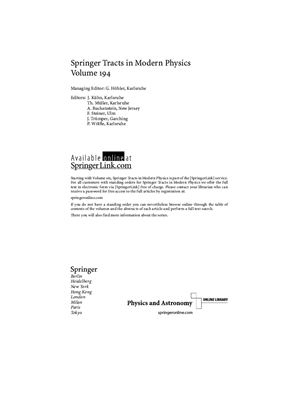Springer-Verlag Berlin, 2003, 282 pages.
This book gives a fascinating report on the state-of-the-art in silicon microphotonics and valuable perspective on what we can expect in the near future. The book presents an overview of the current understanding of obtaining light from silicon. It concentrates mainly on low-dimensional silicon structures, like quantum dots, wires and wells, but covers also alteative approaches like porous silicon and the doping of silicon with rare-earth elements. The emphasis is on the experimental and theoretical achievements conceing the optoelectronic properties of confined silicon structures obtained during recent years. Silicon based photonic crystals are in particular considered, and an in-depth discussion of the route towards a silicon laser is presented. Published results are compared with each other and with the work of the authors. This monograph will be useful not only to physicists, chemists, materials scientists, and engineers interested to the field of microphotonics, but also to graduate students.
The aim of this book is to give a comprehensive account of the efforts made in the last ten years towards light emitting silicon devices. The subjects covered in detail include fundamental considerations about the inability of silicon to emit light efficiently plus the ways to circumvent this problem (Chap. 1) and an overview of the theoretical methods and related results on the electronic and optical properties of low-dimensional silicon structures (Chap. 2). The significant advances, that have been made in order to produce silicon light emitting devices are reviewed. Efficient room temperature visible emission can now be achieved in various forms, such as porous silicon (Chap. 3), silicon superlattices, nanowires or nanocrystals (Chap. 4), erbium doped silicon and erbium doped silicon nanocrystals (Chap. 5). Silicon based light emitting diodes are now reaching the required power efficiency of the severe optoelectronics market and can compete with III-V semiconductors based devices. The main future challenge for silicon photonics is the demonstration of laser action in silicon based materials; two elements are keys to a laser: the amplifying medium and the optical cavity. Silicon microcavities have been fabricated and together with photonics crystals based on silicon are discussed in Chap.
6. Optical gain in silicon nanostructures has been recently demonstrated (Chap. 4). Ten years of research have pushed silicon very near to laser applications, and the future outlook is sketched in Chap. 7.
This book gives a fascinating report on the state-of-the-art in silicon microphotonics and valuable perspective on what we can expect in the near future. The book presents an overview of the current understanding of obtaining light from silicon. It concentrates mainly on low-dimensional silicon structures, like quantum dots, wires and wells, but covers also alteative approaches like porous silicon and the doping of silicon with rare-earth elements. The emphasis is on the experimental and theoretical achievements conceing the optoelectronic properties of confined silicon structures obtained during recent years. Silicon based photonic crystals are in particular considered, and an in-depth discussion of the route towards a silicon laser is presented. Published results are compared with each other and with the work of the authors. This monograph will be useful not only to physicists, chemists, materials scientists, and engineers interested to the field of microphotonics, but also to graduate students.
The aim of this book is to give a comprehensive account of the efforts made in the last ten years towards light emitting silicon devices. The subjects covered in detail include fundamental considerations about the inability of silicon to emit light efficiently plus the ways to circumvent this problem (Chap. 1) and an overview of the theoretical methods and related results on the electronic and optical properties of low-dimensional silicon structures (Chap. 2). The significant advances, that have been made in order to produce silicon light emitting devices are reviewed. Efficient room temperature visible emission can now be achieved in various forms, such as porous silicon (Chap. 3), silicon superlattices, nanowires or nanocrystals (Chap. 4), erbium doped silicon and erbium doped silicon nanocrystals (Chap. 5). Silicon based light emitting diodes are now reaching the required power efficiency of the severe optoelectronics market and can compete with III-V semiconductors based devices. The main future challenge for silicon photonics is the demonstration of laser action in silicon based materials; two elements are keys to a laser: the amplifying medium and the optical cavity. Silicon microcavities have been fabricated and together with photonics crystals based on silicon are discussed in Chap.
6. Optical gain in silicon nanostructures has been recently demonstrated (Chap. 4). Ten years of research have pushed silicon very near to laser applications, and the future outlook is sketched in Chap. 7.

